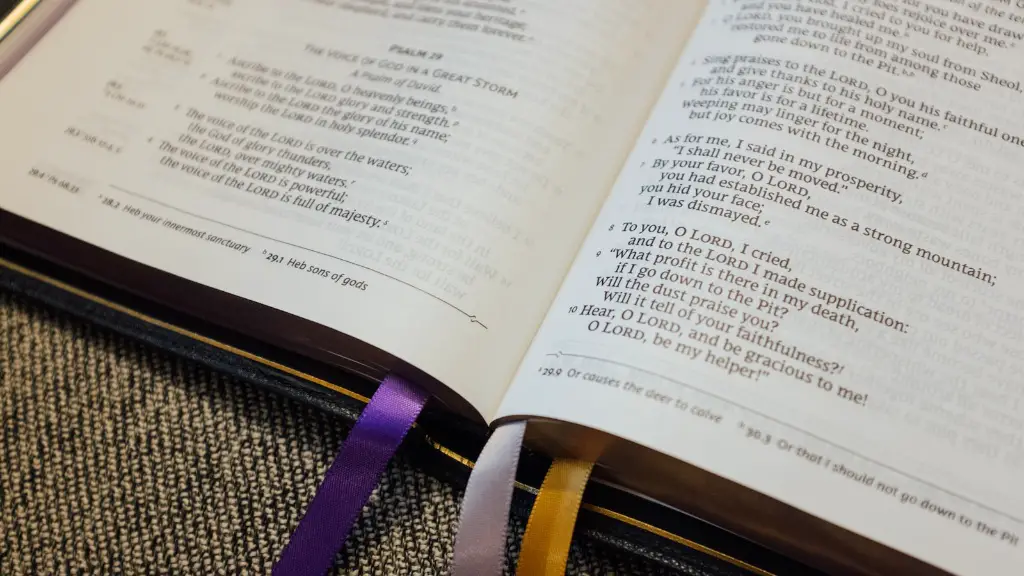Origin
The Feast of Tabernacles is an important part of the Biblical story, going all the way back to the Book of Leviticus. The festival, which is also known as Chag Sukkot in Hebrew, was first commanded in Leviticus 23:33-43. The festival was to be celebrated on the 15th of the seventh month, and was to last for seven days. This day is known as Tishri 15 in the Jewish calendar. Tabernacles was a time for joyous celebration and reflection, commemorating the Israelites’ time spent in the wilderness as they traveled through the Sinai Desert. The festival was meant to be a time for remembering and rejoicing about the crops and abundance earned that year.
Meaning and Practice
The Feast of Tabernacles celebrated the ancient Israelites’ journey through the wilderness and their survival, while also looking ahead to a time of abundance. It was meant to be a time of joy, and was celebrated with singing, dancing, and feasting while living in makeshift huts called sukkot. Once in Jerusalem, the Israelites would pray in the Temple and offer up sacrifices. This was an important ritual for the Hebrews, who honored God and His provision. The symbolic ritual of circling the altar, shaking the willows, and reading the blessings is still celebrated today in the Sukkot holiday.
In the Bible, the Feast of Tabernacles had both spiritual and physical meaning. On a spiritual level, it was a time for reflecting on the divine Providence of God and thanking Him for all His blessings and protection. On a physical level, it was a time of celebration and thanksgiving that looked forward to a time of abundance, but also a time for memory and reflection.
Modern Significance
Modern-day scholars of the Bible suggest that the ancient ritual of the Feast of Tabernacles points towards the ultimate coming of the Spirit of God in the form of the Holy Spirit. According to Jewish tradition, the sukkot were built to symbolize the huts or tents of the Israelites during their travels through the wilderness, yet it is also said that they were built to represent the structure of God’s presence in the world. Tabernacles was seen as a precursor to the coming of the Holy Spirit at Pentecost, when the Apostles were each filled with the Holy Spirit and were empowered to begin preaching the gospel of Jesus Christ.
Today, Sukkot is still celebrated with joy and festivity in many Jewish communities. The holiday is celebrated with special meals, building of the sukkot, and taking part in shared religious and cultural practices such as blessing the fruits of the seven species. There is also a special emphasis put on charity and giving to the less fortunate, following the Biblical command to “love your neighbor as yourself” (Lev. 19:18).
Theology
According to Christian theology, Tabernacles has great significance as a foreshadowing of the coming of the kingdom of God in the life, death, and resurrection of Jesus Christ. In John 1:14, it is said that Jesus “became flesh and tabernacled among us”. Through His life, death, and resurrection Jesus Christ fulfilled the promise of the Feast of Tabernacles: the coming of the Spirit of God, God’s presence in the world. The feast was a sign of God’s enduring love and mercy, and of the hope of eternal life through faith in Jesus.
Symbolism
In the Feast of Tabernacles, there were several symbols used to express the spiritual truth of the festival. The sukkot symbolized the wilderness experience of the Israelites, and the huts themselves were a sign of humility and dependence on God. The taking of the four species–the lulav, myrtle, willow, and citron–in hand and the blessing for the fruit of the seven species showed the dependence of the Jews on God for their sustenance and His protection over them. The lulav palms also symbolized the unity of Israel, with each palm representing a different tribe.
Relevance
The Feast of Tabernacles is still celebrated today by religious Jews, although the observance has changed over the years. For many Jews and Christians alike, the festival serves as a reminder of God’s faithfulness and love, and of His presence in our lives. The festival helps us to remember the importance of our relationship to God and to each other, and to be thankful for God’s blessings and protection. The Feast of Tabernacles is also a time of reflection, reminding us to stay humble and dependent on God, and to always seek His guidance in our lives.
Cultural Impact
The Feast of Tabernacles has had an enduring cultural impact throughout the centuries. It has become an annual reminder of the unity of the Jewish people and their dependence on God, and it has become an important part of Jewish life and culture around the world. Through the celebration of Sukkot, people of all faiths have been able to recognize the importance of humility, charity, and gratitude in our lives. It is also a reminder of the hope of the coming of God’s kingdom in Jesus Christ.
Traditions
The Feast of Tabernacles is celebrated with many different traditional rituals. A hut or sukkah is built and decorated and meals are shared with family and friends. The four species–the lulav, myrtle, willow, and citron–are taken in hand and blessed, and the blessing for the seven species of produce is recited. By tradition, special treats such as groggers (noisemakers) and etrogs (citrus fruits) are enjoyed and the huts are often decorated with fruits, flowers, and other decorations to mark the joyous occasion.
Camping and Hospitality
Although traditional sukkot are built and dwelt in for the duration of the festival, many Jews will go camping or will stay in hotels near their local area to celebrate the festival in a different setting. This is known as Ushavtem May-tay-hoo, which translates to “You shall celebrate it in a good manner”. Many communities also practice hospitality, inviting their neighbors and friends to their homes to share a meal, play music, and enjoy each other’s company.


